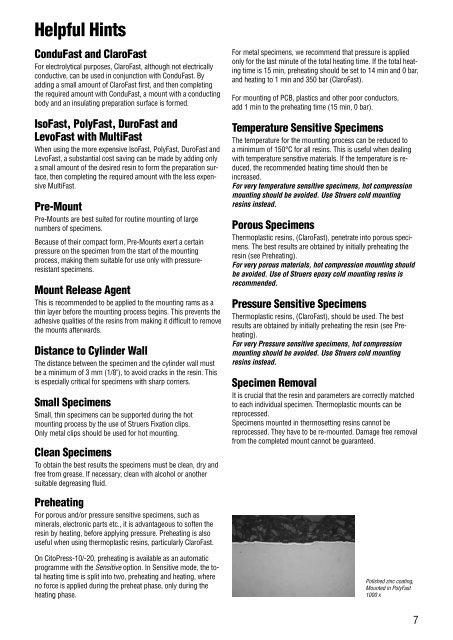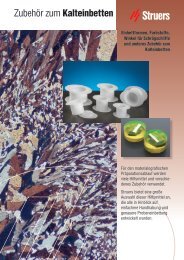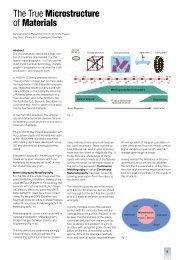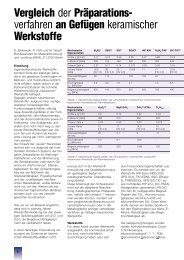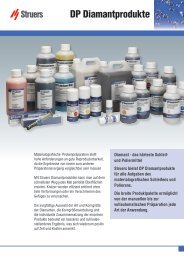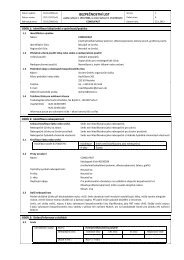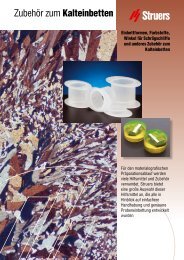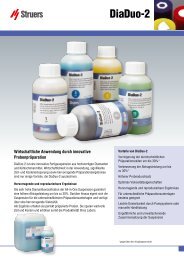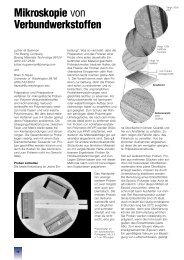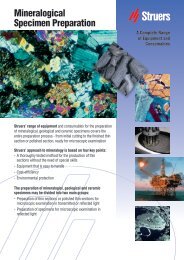Application Guide for Hot Mounting Anwendungshilfen für ... - Struers
Application Guide for Hot Mounting Anwendungshilfen für ... - Struers
Application Guide for Hot Mounting Anwendungshilfen für ... - Struers
Create successful ePaper yourself
Turn your PDF publications into a flip-book with our unique Google optimized e-Paper software.
Helpful Hints<br />
ConduFast and ClaroFast<br />
For electrolytical purposes, ClaroFast, although not electrically<br />
conductive, can be used in conjunction with ConduFast. By<br />
adding a small amount of ClaroFast first, and then completing<br />
the required amount with ConduFast, a mount with a conducting<br />
body and an insulating preparation surface is <strong>for</strong>med.<br />
IsoFast, PolyFast, DuroFast and<br />
LevoFast with MultiFast<br />
When using the more expensive IsoFast, PolyFast, DuroFast and<br />
LevoFast, a substantial cost saving can be made by adding only<br />
a small amount of the desired resin to <strong>for</strong>m the preparation surface,<br />
then completing the required amount with the less expensive<br />
MultiFast.<br />
Pre-Mount<br />
Pre-Mounts are best suited <strong>for</strong> routine mounting of large<br />
numbers of specimens.<br />
Because of their compact <strong>for</strong>m, Pre-Mounts exert a certain<br />
pressure on the specimen from the start of the mounting<br />
process, making them suitable <strong>for</strong> use only with pressureresistant<br />
specimens.<br />
Mount Release Agent<br />
This is recommended to be applied to the mounting rams as a<br />
thin layer be<strong>for</strong>e the mounting process begins. This prevents the<br />
adhesive qualities of the resins from making it difficult to remove<br />
the mounts afterwards.<br />
Distance to Cylinder Wall<br />
The distance between the specimen and the cylinder wall must<br />
be a minimum of 3 mm (1/8"), to avoid cracks in the resin. This<br />
is especially critical <strong>for</strong> specimens with sharp corners.<br />
Small Specimens<br />
Small, thin specimens can be supported during the hot<br />
mounting process by the use of <strong>Struers</strong> Fixation clips.<br />
Only metal clips should be used <strong>for</strong> hot mounting.<br />
Clean Specimens<br />
To obtain the best results the specimens must be clean, dry and<br />
free from grease. If necessary, clean with alcohol or another<br />
suitable degreasing fluid.<br />
For metal specimens, we recommend that pressure is applied<br />
only <strong>for</strong> the last minute of the total heating time. If the total heating<br />
time is 15 min, preheating should be set to 14 min and 0 bar,<br />
and heating to 1 min and 350 bar (ClaroFast).<br />
For mounting of PCB, plastics and other poor conductors,<br />
add 1 min to the preheating time (15 min, 0 bar).<br />
Temperature Sensitive Specimens<br />
The temperature <strong>for</strong> the mounting process can be reduced to<br />
a minimum of 150°C <strong>for</strong> all resins. This is useful when dealing<br />
with temperature sensitive materials. If the temperature is reduced,<br />
the recommended heating time should then be<br />
increased.<br />
For very temperature sensitive specimens, hot compression<br />
mounting should be avoided. Use <strong>Struers</strong> cold mounting<br />
resins instead.<br />
Porous Specimens<br />
Thermoplastic resins, (ClaroFast), penetrate into porous specimens.<br />
The best results are obtained by initially preheating the<br />
resin (see Preheating).<br />
For very porous materials, hot compression mounting should<br />
be avoided. Use of <strong>Struers</strong> epoxy cold mounting resins is<br />
recommended.<br />
Pressure Sensitive Specimens<br />
Thermoplastic resins, (ClaroFast), should be used. The best<br />
results are obtained by initially preheating the resin (see Preheating).<br />
For very Pressure sensitive specimens, hot compression<br />
mounting should be avoided. Use <strong>Struers</strong> cold mounting<br />
resins instead.<br />
Specimen Removal<br />
It is crucial that the resin and parameters are correctly matched<br />
to each individual specimen. Thermoplastic mounts can be<br />
reprocessed.<br />
Specimens mounted in thermosetting resins cannot be<br />
reprocessed. They have to be re-mounted. Damage free removal<br />
from the completed mount cannot be guaranteed.<br />
Preheating<br />
For porous and/or pressure sensitive specimens, such as<br />
minerals, electronic parts etc., it is advantageous to soften the<br />
resin by heating, be<strong>for</strong>e applying pressure. Preheating is also<br />
useful when using thermoplastic resins, particularly ClaroFast.<br />
On CitoPress-10/-20, preheating is available as an automatic<br />
programme with the Sensitive option. In Sensitive mode, the total<br />
heating time is split into two, preheating and heating, where<br />
no <strong>for</strong>ce is applied during the preheat phase, only during the<br />
heating phase.<br />
Polished zinc coating,<br />
Mounted in PolyFast<br />
1000 x<br />
7 7


